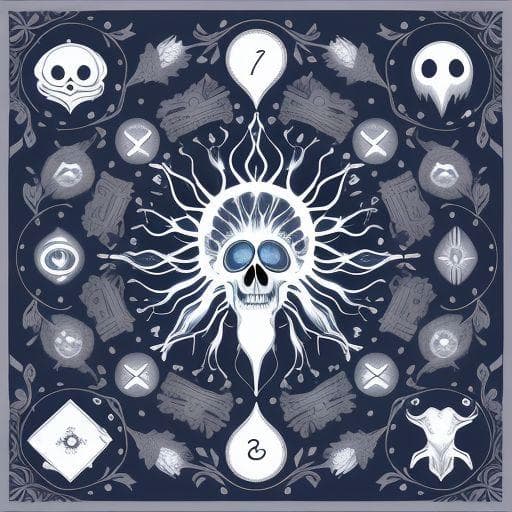Saved
Saved
There are no items here
Menu

Ghost Classifications Name Generator
Generate unique and captivating ghost classification names for your fantasy world with this cool tool. Perfect for D&D and other imaginative adventures.
Class 3 Destructive Glob
Rank 1 Teasing Mutation
Grade 2 Slumbering Daemon
Category 5 Wandering Tempus
Class 5 Docile Visitor
Grade 1 Radioactive Metamorph
Type 5 Forsaken Phantasm
Class 5 Dumb Daemon
Type 2 Dormant Phantom
Grade 2 Grieving Ghost
Grade 1 Sorrow Spirit
Type 5 Aquatic Wraith
You might also like
Ghost Name Generator
Generate unique, cool ghost names for your fantasy or DND game using our Ghost Names Generator tool.
Death Name Generator
Generate cool, fantasy style death names with our Death Names Generator tool, perfect for DnD and other RPGs.
Curse Name Generator
Generate cool, fantasy curse names for DnD with our Curse Names Generator tool. Perfect for adding a unique twist to your game!
Introduction to Ghost Classifications
Ghost classifications are a way to categorize and understand different types of ghosts based on their characteristics and behaviors. By classifying ghosts, we can gain a better understanding of their nature and potentially uncover patterns or similarities among them.
How to Use the Ghost Classification Generator?
Using the Ghost Classifications Generator is simple and straightforward. Just follow these steps:
Step 1: Choose the desired ghost classification
Start by selecting the type of ghost classification you are interested in exploring. The generator offers a variety of options, including traditional ghost types, elemental spirits, and more.
Step 2: Select any specific preferences (optional)
If you have any specific preferences or criteria for the generated ghost classifications, you can specify them in this step. For example, you can choose to focus on a particular time period or geographical region.
Step 3: Generate ghost classifications
Click on the "Generate" button to generate a list of ghost classifications based on your chosen parameters. The generator will use an algorithm to create unique and fitting names for each classification.
Step 4: Explore the generated names
Once the ghost classifications have been generated, you can explore the list and see the names that have been created. Each name will be accompanied by a brief description or explanation of the classification.
Generated Ghost Classifications
| Ghost Classification | Description |
|---|---|
| Apparition | An apparition is a ghostly figure that appears to humans, often associated with specific locations or events. |
| Poltergeist | A poltergeist is a mischievous and disruptive ghost known for its ability to move objects and create disturbances. |
| Residual Haunting | A residual haunting is a replay of past events or emotions that are imprinted on a location, often without any conscious interaction with the living. |
| Intelligent Haunting | Intelligent hauntings involve spirits that interact with the living and display awareness of their environment. |
| Shadow People | Shadow people are dark, shadow-like figures seen out of the corner of the eye, often considered omens or watchers. |
| Orbs | Orbs are spherical forms of light believed to be spirits captured in photos or videos. |
| Phantom | Phantoms are ghostly entities that manifest to deliver a message or serve as omens. |
| Wraith | Wraiths are often malevolent and tormented spirits, associated with a tragic or violent death. |
| Banshee | Banshees are spirits that wail or scream, traditionally believed to foretell death in a family. |
| Elemental Spirit | Elemental spirits are believed to be ghosts connected to natural forces, such as wind, water, or fire. |
Understanding Ghost Classifications
There are various types of ghost classifications, each with its own unique characteristics and behaviors. Some common types include:
Class A Ghosts
Class A ghosts are often considered the most powerful and interactive. They can manifest physically and communicate with the living.
Class B Ghosts
Class B ghosts are less interactive than Class A ghosts but can still make their presence known through various means, such as moving objects or creating cold spots.
Class C Ghosts
Class C ghosts are the least interactive and typically appear as residual hauntings or apparitions. They do not interact with the living and are often associated with specific locations.
Tips for Naming Ghost Classifications
When naming ghost classifications, consider the following tips:
Create unique and fitting names
Choose names that accurately reflect the characteristics and behaviors of the ghost classification. Avoid generic or overused names.
Consider the historical context
If the ghost classification is based on a specific time period or geographical region, consider incorporating elements from that context into the name.
Use descriptive language
Include descriptive words or phrases in the names to give them more depth and meaning. This can help convey the nature of the ghost classification more effectively.
Importance of Ghost Classifications
Categorizing ghosts into different classifications is important for several reasons:
Understanding and research
By categorizing ghosts, researchers and paranormal enthusiasts can better understand their nature and potentially uncover patterns or similarities among different types of ghosts.
Communication and documentation
Having standardized classifications allows for more effective communication and documentation of ghostly encounters. It provides a common language and framework for discussing and sharing experiences.
Identifying and addressing specific phenomena
By identifying specific ghost classifications, it becomes easier to address and investigate specific phenomena associated with those types of ghosts. This can lead to a better understanding of how to interact with or mitigate potential disturbances.
For additional resources on ghost classifications, consider the following:
- Books: "Ghosts: A Classification Guide" by Paranormal Research Society
- Online forums and communities dedicated to paranormal research and ghost hunting